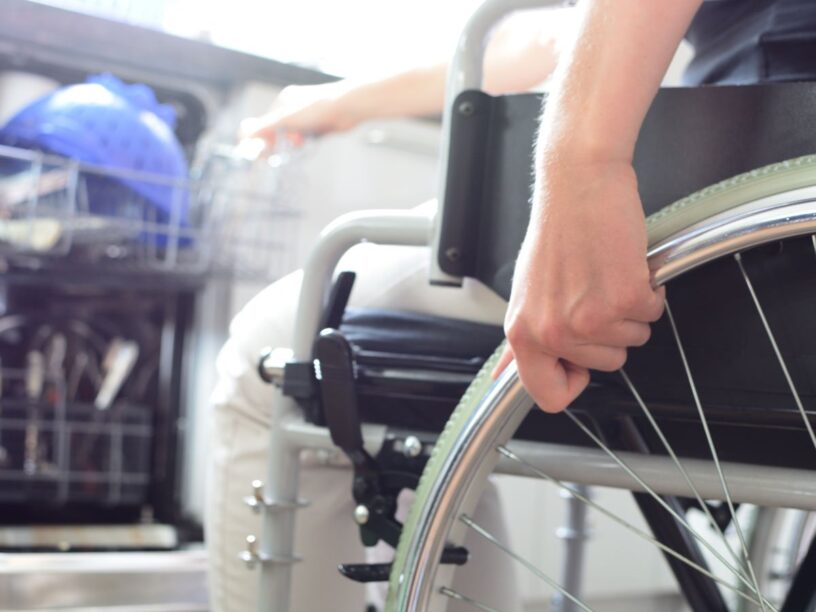In order to be able to use the kitchen for mobility-restricted people, it can be made barrier-free. Here is our guide for what to do for during planning and conversion to make a kitchen accessible.
In order for the local kitchen to be barrier-free, it must be able to be used independently by people with physical disabilities, including furniture, built-in appliances and other utensils. Even small measures such as adjusting the working heights of the sink, worktop or hob make it easier for older people with reduced physical activity to make a kitchen accessible, which is a crucial factor in
how to plan a senior-friendly kitchen.
Depending on the requirements, it may also be that the kitchen has to be completely converted, for wheelchair users, for example. These have an increased space requirement and rely on the fact that the work areas are accessible. This means that there should be no cabinets under the worktop. Under sinks and cooktops must then remain free 67 cm depth, so they can get close enough to these areas.
Increased installed appliances such as oven or dishwasher are easier to reach. For this, usually the kitchen cabinets must be adjusted accordingly. It becomes more complex and expensive if you want to install height-adjustable worktops or high-bay shut-down cabinets by electric motor. This article will tell you how to do make it easier for people with mobility problems to be able to use the kitchen.
Make a kitchen accessible: Define requirements
As always, when it comes to the adaptation of the living area, the own needs are in the foreground. And, of course, the consideration with which retrofitting measures you can meet the personal restrictions.
First of all, you should then make a list of the requirements currently in use for the kitchen and how they might change in the foreseeable future. This list can then be used to determine how extensive the adjustments need to be: Is it enough to change the working heights and to provide seating? Do the built-in appliances have to be placed higher? Or should the kitchen be based on the requirements of a wheelchair user, that is with an accessible worktop, retractable wall cabinets and remote-controlled extractor hood?
Kitchen items with accessibility adjustments:
Worktop: Underrun height at knee height (guide value: 67 cm)
Dishwasher: height variable from 40 to 140 cm
Wastewater connection of the sink with under- or flat-mounted siphon
Height adjustable wall units
Remote-controlled extractor
Oven with revolving door
Refrigerator height variable from 40 to 140 cm
Movement area for wheelchair users at least 150 x 150 cm
Increased space requirement for wheelchair users
A kitchen that can be used by wheelchair users has special requirements, such as a larger space and the mobility of furniture. As barrier-free according to DIN 18040-2, there is a movement area for turning and turning of 120 x 120 cm, for wheelchair users it is 150 x 150 cm. Similarly, 120 cm are required in front of kitchen furniture, wheelchair users again 150 cm.
The stove, worktop and sink should ideally be arranged over the corner and wheelchair accessible. For the dining area is: The width of the dining table should be 80 cm, the retractable height of the table top 60 cm. Possibilities for maneuvering and a corresponding width between the table legs are recommended.
Distribution and ergonomics of the accessible kitchen
For people with reduced mobility, it is important to arrange the “magic triangle” of supply, rinsing and cooking in such a way that the stations are as far as possible accessible with only one rotary movement. For right-handed people, storage and storage cabinets, sink and dishwasher as well as the preparation and cooking area are arranged in a clockwise direction.
Simple kitchen lines inevitably result in a row instead of a triangle. For island kitchens, L-shaped kitchens, U-shaped kitchens and two-line kitchens, one must also consider the freedom of movement and the paths between the individual stations: as short as possible, but with enough room for movement, ie 120 or 150 cm. Investigations prove that in arbitrarily arranged kitchens one lays about 2.5 times more distance than in those with ergonomic planning.
Height-adjustable worktops
Whether you want to work while standing or sitting: adjustable worktops adapt to the desired working height at the touch of a button via an integrated electric motor. The plate height can be adjusted steplessly in height. Such solutions are available both for wall mounting and as a stand-alone solution in the trade. The worktop lifts are also available as L-shaped angle modules.
Important: A clamping protection integrated on the underside prevents injuries.
Shut-off kitchen cabinets
What works for the work surface, there is also a relief for wall cabinets. As an insert for existing wall units of 40 to 100 cm width, for example, the lift “Verti” from Granberg (from 2,000 euros) lowers the contents of each cabinet to the level of the worktop.
It is suitable for wall units with a minimum height of 70 cm and is available with a depth of 26.5 or 31 cm. Here again, pinch protection prevents injuries or objects from being damaged on the worktop. The insert is also available with underfloor lights.
Transform built-in appliances barrier-free
All electrical appliances such as oven, microwave, refrigerator, freezer and dishwasher are easier to access when installed at the appropriate height. Depending on whether you want to reach the built-in appliances while sitting or standing, installation heights between 40 and 140 cm offer. So you can populate and clear them without much effort.
To avoid accidents and burns, it is recommended to install an induction hob. This does not get as hot as other heat sources and works only when a pot is on the plate. For this purpose, induction-capable pots and pans are necessary.
Helpful is also an extendable worktop on which you can temporarily turn off hot pots from the oven. Even with ovens such a pull-out tray makes sense. Finally, with ovens, a revolving door that opens to the side instead of down is ideal.
Retrofitting base cabinets with pull-outs
Firmly built base cabinets are out of place in the barrier-poor kitchen. The shelves behind the closet door are difficult to reach. A better alternative are base cabinets on wheels. They can be easily moved if necessary and free the space under the work surface for the legs, if you want to sit down or position yourself with the wheelchair.
Even better are drawers and excerpts that “stretch” their contents to the user. They are easily accessible from two sides and can be easily organized by using them if necessary. So-called pharmacist cabinets contain a drawer that extends over the entire cabinet height.
Bring the sockets and extractor hood within reach
Even for minor problems that only catch the eye at a second glance, there are solutions. Wall-mounted sockets, for example, are inaccessible from the sitting position across the worktop. Remedy sockets, which can be integrated into the kitchen front. This makes it easy to connect blenders and food processors.
Anyone who sits in the kitchen and can not get up will not be able to activate a conventional cooker hood. And the integrated lighting for the hob then stays off. But there are models with remote controls.
Another possibility is a hob with integrated extractor hood. The disadvantages: In comparison, they are quite expensive. In addition, they have a greater installation depth and make it difficult to drive under.
 Gerhardt Richter is a writer and a trainer at trade technical colleges, specializing in carpentry, plumbing, mechanics and construction.
Gerhardt Richter is a writer and a trainer at trade technical colleges, specializing in carpentry, plumbing, mechanics and construction.




